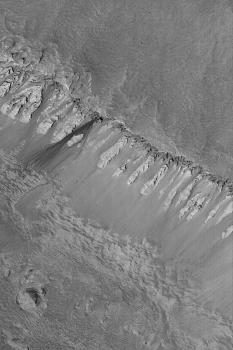
Mars Global Surveyor
Mars Orbiter Camera
Rock Slide in Ophir
MGS MOC Release No. MOC2-719, 7 May 2004

NASA/JPL/Malin Space Science Systems |


NASA/JPL/Malin Space Science Systems |
The dark streaks, just left of center, on the steep slope in this Mars Global Surveyor (MGS) Mars Orbiter Camera (MOC) image were formed by a relatively recent rock slide. The streak closest to the center of the image resolves into a series of small depressions, indicating the path of a large, rolling boulder. The rock slide is inferred to have been recent (i.e., within the past several Mars years) because it is so much darker than its surroundings---there has not been sufficient time for the streak surfaces to become mantled by dust. The other talus accumulations on this slope are most likely lighter in tone because they are older and coated with dust. These features are located in Ophir Chasma, part of the Valles Marineris trough system, near 4.2°S, 74.0°W. The picture is illuminated by sunlight from the lower left and covers an area about 3 km (1.9 mi) across.
Malin Space Science Systems and the California Institute of Technology built the MOC using spare hardware from the Mars Observer mission. MSSS operates the camera from its facilities in San Diego, California. The Jet Propulsion Laboratory's Mars Surveyor Operations Project operates the Mars Global Surveyor spacecraft with its industrial partner, Lockheed Martin Astronautics, from facilities in Pasadena, California and Denver, Colorado.